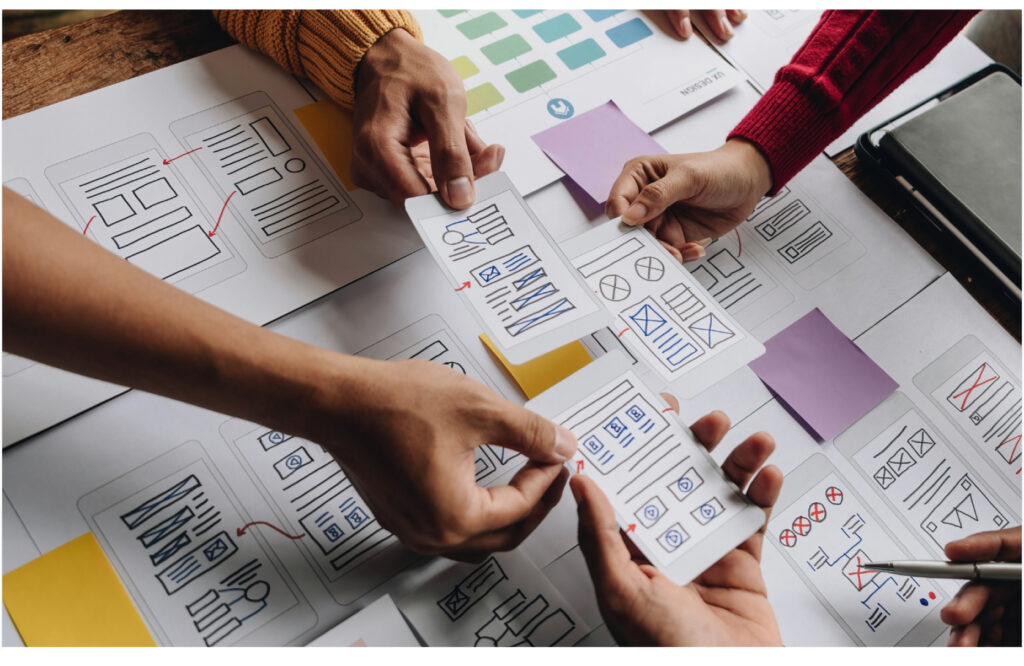Before contacting a Software Development Company that will potentially create your application, check the list of questions you need to know the answers to. The list will prepare you for the conversation so that you will be treated as a partner and receive a valuable offer. Additionally, the Agency will be able to more accurately estimate the required time and expected cost of building the application.
Checklist:
1. Who is the target audience of the application? Individual customers (B2C), businesses (B2B), or is it an internal application (i.e. dedicated to employees of a particular company, participants of a particular event)?
The choice of target audience affects how your application will be designed and developed in terms of functionality and technology. A thorough understanding of user needs will help create a product that meets their expectations. The answer to this question will also help estimate the expected number of users, which is important to better plan server infrastructure and resources needed to handle traffic.
2. On which platforms should the application be available? Apple Store, Google Play, Huawei AppGallery?
Publishing applications in stores entails fees and the need to meet store requirements, such as the possibility of account removal or regular application updates. You should plan ahead whether the application should be available for a broad audience who use different devices or just for Android smartphone users, for example.
3. What user problem does the application solve and what need does it satisfy?
This will help advise better functional solutions and assess which functionalities are essential at a given stage. The answer determines the primary reason the application should be created.
4. Who is the typical user of the application?
Knowing the profile of the typical user allows the interface, content, and features of the application to be tailored to better suit their preferences. This will be most critical at the UX/UI design stage, answering questions like: Are large buttons, fonts, and contrasts needed? What graphic style is suitable for the target audience?
5. In what situation will the application be used?
This can suggest what technological solutions will be necessary and what will be redundant. For example, do we expect the application to be used in areas with poor internet reception (e.g. by field workers) and need to partly work offline? The context of using the application is essential for interface design, content delivery, and tailoring app features to user needs.
6. How crucial is registration/logging in?
You should consider whether the application requires registration and logging in at all. Equipping it with these functions leads to further needs, such as authentication, profile editing, logout, or password reminders. You should also think about how this will be done – via the user’s email address or do you need to integrate other accounts like Google, Apple, Facebook, etc.? Or perhaps via SMS code confirmation? The greater the functional scope, the larger the required investment.
7. How many types of users does the application anticipate?
One application can have multiple user roles. It’s best to illustrate it using an example: mobitouch’s team has created the platform maturalni.com (see case study). The project consists of an e-learning app with a store selling the platform’s original courses and an admin panel. There are three types of users: student (further divided by school type), teacher, and administrator. The “Student” can buy a course, participate in it, and take advantage of live webinar opportunities with the teacher. The “Teacher” can edit and view their courses and webinars along with the number of participants. The “Administrator” user has access to all reports and statistics, the ability to edit marketing content and notifications, and manage the calendar.
A common mistake of startups at an early stage is to focus on functionalities related to the target user (client) and forget that the application may also need other roles, such as an admin. An extensive admin panel may be needed for managing users, their roles, and the content of the application itself. In such a case, the cost of investment may surprise you and be higher than initially assumed. If you don’t know how many types of users you need and what functionalities an admin panel should have, use the contact button and schedule a meeting with us. We will provide a consultation for your challenge free of charge.

8. What similar applications (design and functional solutions) are out there, and how does yours stand out?
Share examples of existing solutions and applications that may be your competition to better understand your vision and goals. This way, the entire process will be free from misunderstandings and much smoother. It’s best to show how the application should look and function based on an existing example as it will significantly facilitate the work of designers and developers.
The competition in the market is tight, so you need to be confident in the value of your solution. The advantage of your application doesn’t have to be its main function, but perhaps the user experience, which is influenced by the application’s clarity, lack of ads, speed, or ease of reaching specific information (number of clicks, intuitiveness).
9. Do you want the user to receive push notifications informing them about various events in the application or marketing information?
If you’re creating a mobile application, consider whether you want users to receive push notifications. If the answer is yes, think about whether they will be related to the user’s activity in the application, e.g., notification about achieving a daily step goal (health application), or whether they will be general marketing messages, e.g. new discounts (in the case of an online store).
10. Is there a need to integrate the application with external APIs?
If your application needs to communicate with other systems to send or receive data, this means that it requires API integration (important information to include in the brief). An example could be exchanging data about purchase history in an online store or retrieving information about air quality from sensors.
11. Do you need multiple language versions?
The application usually automatically fetches the user’s phone language settings and assigns a language from the available options in the application. Multiple language versions are not a problem, but remember that adding more takes extra time. If you currently only need one language version but know that the application will need to support multiple languages in the future, include this information in the brief. This will allow the developers to design the application architecture to accommodate multilingualism.
12. How will the application generate revenue (if that’s the objective)?
With this information, you can better determine which functionalities are a priority. If it’s an internal application for your employees, you don’t have to think about this, of course. However, if the application is for commercial use, this is a crucial issue. Will the user need to pay to install the application (payment through the App Store / Google Play) or will it offer in-app purchases? Additionally, will there be a free trial period? Will only the premium version be paid?
13. What is your budget?
Try to avoid answers like “I don’t know,” or “I’m just collecting offers.” If you want to be treated as a partner, specify the expected budget you are willing to invest in building your product. The contractor will appreciate your decisiveness and will also provide specific information: they can suggest what is possible within the budget and recommend alternative solutions. By saying “I don’t know,” you signal a lack of readiness to commit to the project or simply a lack of funds for investment.
14. How will you finance the creation of the application?
The contractor wants to check how serious you are about the project. At the point when you’re contacting a Software Development Company, it is expected that you already have a source of funding or a specific plan to obtain it. The answer to this question is equivalent to information about whether cooperation will happen at all, so it is a very important question for your contractor, who will have to dedicate a lot of time and resources before the actual cooperation takes place—usually involving several people in the analysis of your idea and its estimation. Additionally, knowing the financing capabilities of the project, the contractor can plan the team’s work such as expected start and length of engagement.
15. Do you already have documentation in the form of UX/UI mockups, user stories, a list of functionalities, or other?
Such documentation is the first step to building a digital product. The more extensive and better described, the more accurately you can estimate the real costs of your investment. By minimizing the risk of misunderstandings that arise from too little information about the project, it will also be easier for you to compare offers from different contractors.
If you don’t have such documentation yet, you can create it with us during Product Discovery workshops.







